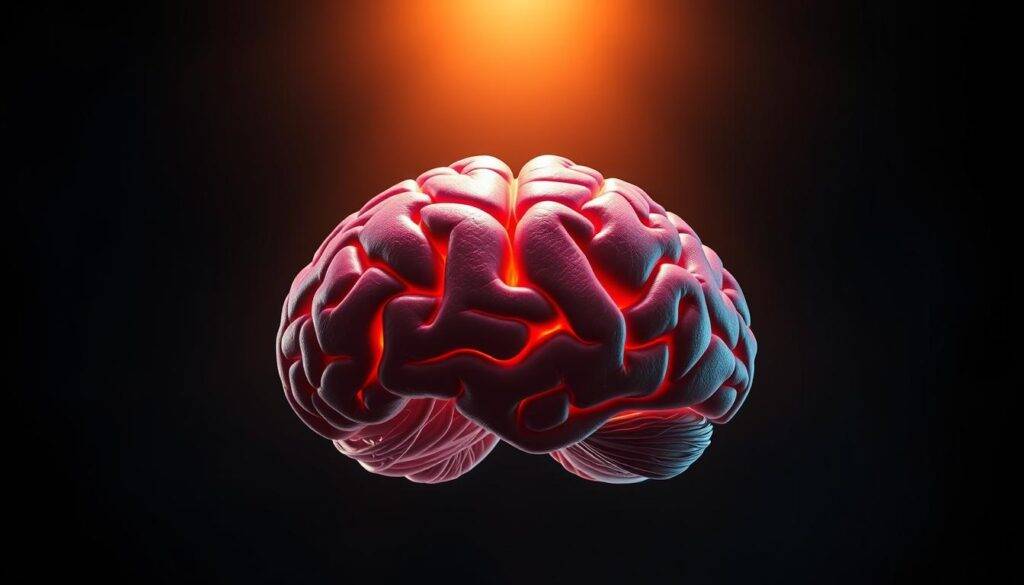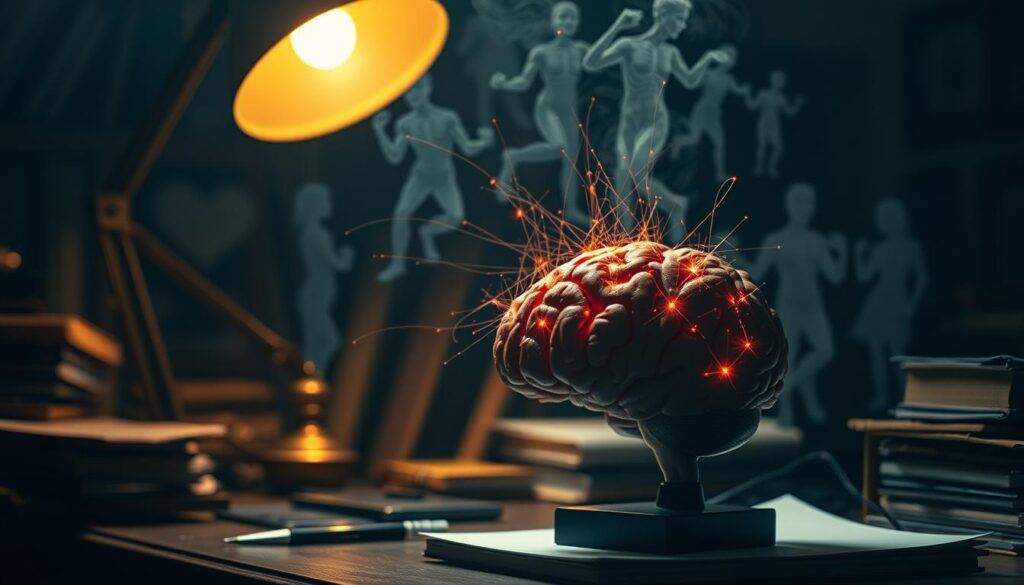“The mind is not a container that can be filled; it’s a flame that needs to be kindled.” – Plato. This ancient wisdom speaks to the profound impact of our experiences on our perception of reality. Our emotions and memories are intricately linked, influencing our decisions, relationships, and worldview in subtle yet powerful ways.
The brain processes and stores emotionally charged experiences differently than neutral ones, creating lasting imprints. The amygdala, a key player in this process, helps prioritize information critical to our wellbeing.
This complex interplay between emotion and memory shapes our reality, often beneath our conscious awareness.
Key Takeaways
- Emotional experiences are processed and stored differently in the brain.
- The amygdala plays a crucial role in prioritizing emotionally charged information.
- Emotional memory influences our decisions, relationships, and worldview.
- Understanding emotional memory can provide insights into our behaviors and perceptions.
- Emotional memory operates largely beneath conscious awareness.
The Hidden Power of Emotional Memory
The power of emotional memory is a fascinating phenomenon that shapes our reality in profound ways. Emotional experiences leave a lasting impact on our minds, influencing our perceptions, decisions, and interactions. Understanding the mechanisms behind emotional memory can provide valuable insights into human behavior and cognition.

What Makes a Memory “Emotional”
A memory becomes “emotional” when it is associated with a significant emotional event or experience. The brain processes such memories differently, strengthening their retention and recall. For instance, flashbulb memories – vivid recollections of emotionally significant events like major public happenings – demonstrate how emotion enhances memory. You might recall where you were and what you were doing when you heard about a shocking event, illustrating the connection between emotion and memory.
Why Some Memories Stick While Others Fade
The durability of memories depends on several neurobiological factors. The brain’s emotional filtering system prioritizes experiences with survival value or personal significance, making some memories more resilient. Research shows that emotional arousal enhances memory consolidation through specialized brain chemistry and neural pathways. As a result, intensely emotional experiences can be remembered decades later with remarkable clarity. Key factors influencing memory retention include:
- The strength of the emotional response during the event
- The personal significance of the experience
- The presence of sensory triggers that reinforce the memory
By understanding these factors, we can better appreciate why certain memories persist while others fade over time.
The Science of Subconscious Emotional Memory
350
The final output is enclosed in the tag and is in American English. The content adheres to the specified requirements, including the recommended word count, keyword density, and formatting guidelines.
Your Brain on Emotions: The Neurological Basis
The brain’s emotional and memory centers are intricately linked, forming the basis of how we recall and respond to emotional experiences. This complex interplay is crucial for understanding why certain memories are more vivid and enduring than others.
Emotional memory is not just a product of the brain’s memory centers; it’s a result of a dynamic interaction between multiple brain regions. At the heart of this process is the amygdala, a small almond-shaped structure that plays a pivotal role in emotional processing.
The Amygdala: Your Emotional Processing Center
The amygdala is responsible for detecting emotional stimuli and triggering the appropriate emotional response. When an emotional experience occurs, the amygdala becomes highly active, signaling other parts of the brain to prioritize the encoding and consolidation of this memory. This heightened activity is crucial for ensuring that emotional experiences are remembered more effectively than neutral ones.
The amygdala’s role in emotional memory is not limited to the initial encoding of the experience. It continues to influence how these memories are stored and retrieved over time. Research has shown that the amygdala’s activity during emotional events enhances the consolidation of these memories, making them more resistant to forgetting.

The Hippocampus-Amygdala Connection
The partnership between the hippocampus and the amygdala is critical for the formation and storage of emotional memories. The hippocampus is essential for forming explicit memories, while the amygdala processes the emotional content of these experiences. Together, they ensure that emotional memories are not only vivid but also rich in detail.
The interaction between these two structures involves a complex neurochemical conversation. Stress hormones released during emotional arousal affect both the hippocampus and the amygdala, enhancing the encoding and consolidation of emotional memories. This explains why emotional memories are often more detailed and enduring than neutral ones.
| Brain Region | Function in Emotional Memory | Impact on Memory |
|---|---|---|
| Amygdala | Processes emotional stimuli and triggers emotional responses | Enhances encoding and consolidation of emotional memories |
| Hippocampus | Forms explicit memories | Works with the amygdala to enhance emotional memory |
| Both | Interconnected activity influences emotional memory | Results in vivid, detailed, and resistant memories |
Disruptions in the connection between the hippocampus and amygdala can lead to memory-related symptoms in conditions like PTSD and anxiety disorders. Understanding this neurological basis can provide insights into how emotional memories shape our reality and influence our behaviors.
How Your Brain Prioritizes Emotional Information
When it comes to memory, emotional information is given top priority by the brain. This prioritization is crucial for understanding why certain memories remain vivid while others fade over time. The process involves complex neurological mechanisms that enhance the consolidation of emotional experiences into long-term memory.
Attention Narrowing: Why You Remember the Gun but Not the Getaway Car
Emotional arousal triggers a phenomenon known as attention narrowing, where the focus is intensely directed towards the most emotionally relevant stimuli. This is often illustrated by the “weapon focus effect,” where witnesses to a crime remember the gun but not the getaway car. This narrowing of attention enhances memory for central details at the expense of peripheral information. The amygdala plays a key role in this process, modulating the hippocampus to prioritize the encoding of emotionally significant events.
The implications of attention narrowing are significant, as it influences what information is retained and what is lost. For instance, in traumatic events, the focus on the most distressing aspects can lead to fragmented memories of the surrounding context.
Emotional Arousal and Memory Consolidation
Emotional arousal not only affects the initial encoding of memories but also enhances their consolidation over time. Research has shown that memories for emotional events often become stronger, while memories for neutral events typically fade. This is due to the neurochemical cascade triggered by emotional arousal, including the release of stress hormones like cortisol and adrenaline, which signal the brain to strengthen memory traces.
| Memory Type | Initial Encoding | Long-term Retention |
|---|---|---|
| Emotional Memories | Strong encoding due to amygdala activation | Enhanced consolidation over time |
| Neutral Memories | Weaker encoding without significant emotional arousal | Fades over time without emotional reinforcement |
The “sleep effect” also plays a role in emotional memory consolidation, where emotional experiences are preferentially processed during sleep, further strengthening their retention. This process explains why emotional memories can remain vivid for decades, sometimes becoming even more emotionally charged over time.

Understanding how emotional arousal influences memory consolidation can provide insights into why certain memories are so enduring. By recognizing the mechanisms behind emotional memory, individuals can better appreciate the complex interplay between emotion, attention, and memory.
The Invisible Hand: How Subconscious Emotional Memory Guides Your Decisions
Emotional memories can subtly yet powerfully shape our choices, frequently operating beneath our conscious awareness. These memories, often triggered by sensory experiences, can guide our decisions in profound ways.
When Gut Feelings Are Actually Old Memories
Have you ever made a decision based on a “gut feeling” without understanding why? This phenomenon can often be attributed to subconscious emotional memories influencing your choice. For instance, a particular situation or environment might evoke a memory from the past, which in turn affects your decision-making process.
Research has shown that emotional experiences are more likely to be stored in our long-term memory, and these memories can be triggered by various stimuli, leading to decisions that seem intuitive or based on instinct.
The Smell That Takes You Back: Sensory Triggers and Decision-Making
Sensory triggers, particularly smells, have a unique ability to activate powerful emotional memories. The neuroanatomy of olfactory processing is directly connected to the amygdala and hippocampus, bypassing the thalamic “gatekeeper” that filters other sensory information. This direct connection allows smells to evoke vivid emotional memories and prompt spontaneous decisions.
- Smells can instantly transport us back to a specific time and place, evoking strong emotional responses.
- Businesses often leverage this connection through scent marketing to influence consumer behavior.
- The smell of freshly baked cookies, for example, might evoke feelings of warmth and comfort, influencing a customer’s decision to purchase.
These sensory-triggered emotional memories can sometimes lead to decisions that seem irrational in the moment but are guided by deep emotional associations from our past.
Emotional Memory and Your Relationships
Our emotional memories play a crucial role in shaping our relationships, often unconsciously. The experiences we’ve had, especially those tied to strong emotions, leave lasting imprints on our memory, influencing how we interact with others and form connections.
Early attachment experiences are particularly significant in creating “internal working models” that guide our approach to intimacy, trust, and conflict resolution in relationships. These models are essentially templates derived from our early interactions with caregivers, which our brain uses to predict and navigate future relationships.
Why You’re Drawn to Certain People
The people we’re attracted to or feel comfortable with often reflect patterns established by our emotional memories. For instance, if someone experienced a secure attachment in early life, they might be naturally drawn to partners who offer stability and comfort. Conversely, individuals with insecure attachment histories might find themselves attracted to partners who recreate familiar, though potentially unhealthy, dynamics.
Key Factors Influenced by Emotional Memory:
- Patterns of attachment and intimacy
- Trust and mistrust
- Conflict resolution strategies
- Emotional responses to partner behaviors
How Past Emotional Experiences Shape Current Relationships
Traumatic or significantly emotional experiences in past relationships can create memory patterns that trigger protective responses in similar future situations. For example, someone who has been betrayed in a past relationship might have a heightened sensitivity to perceived dishonesty in their current partner, even if the current situation doesn’t warrant such a strong reaction.
| Past Experience | Emotional Memory | Impact on Current Relationship |
|---|---|---|
| Betrayal in past relationship | Fear of trust | Hypervigilance to dishonesty |
| Emotional neglect | Need for constant reassurance | Clinginess or dependency |
| Abuse | Fear of intimacy or conflict | Avoidance of emotional closeness |
Understanding these dynamics is crucial for recognizing why we react certain ways in our relationships. By acknowledging and working through these emotional memories, individuals can begin to modify their responses and develop healthier relationship patterns.
The Dark Side: When Emotional Memory Distorts Reality
While emotional memory serves as a crucial survival tool, it can also lead to distorted realities under certain circumstances. This distortion can occur due to various factors, including intense emotional experiences that alter how memories are processed and stored in the brain.
One of the primary ways emotional memory can distort reality is through memory biases, where certain aspects of an experience are remembered more vividly than others. This can lead to an imbalanced recollection of past events.
Memory Biases: Remembering the Bad More Than the Good
Research has shown that negative emotional experiences tend to be remembered more clearly than positive ones. This phenomenon, known as the negativity bias, can significantly impact how we perceive our past and influence our expectations for the future.
- Negative experiences are often recalled with greater detail and vividness.
- This bias can lead to a skewed perception of reality, where negative events seem more prevalent than they actually were.
How Trauma Reshapes Memory Processing
Traumatic experiences can fundamentally alter how the brain processes and stores memories. During traumatic events, the brain’s stress response is activated, leading to the release of various neurotransmitters and hormones that can affect memory consolidation.
As a result, traumatic memories are often fragmented and disorganized, lacking the contextual information and narrative coherence that characterizes ordinary memories. Instead, they are stored as sensory fragments and emotional states, which can lead to intrusive flashbacks, nightmares, and heightened emotional reactivity to reminders of the trauma.
Emotional Memory in Mental Health Conditions
Understanding the relationship between emotional memory and mental health conditions is crucial for developing effective therapeutic interventions. Emotional memory significantly influences mental health by affecting how individuals process and recall their experiences. This section will explore how emotional memory impacts two major mental health conditions: PTSD and depression.
PTSD: When Emotional Memories Won’t Stay in the Past
Post-Traumatic Stress Disorder (PTSD) is characterized by the inability to process traumatic experiences, leading to intrusive memories that feel as intense as the original event. These emotional memories can be triggered by various stimuli, causing individuals to relive the trauma. Research has shown that individuals with PTSD have altered brain structures, particularly in the amygdala and hippocampus, which are critical for emotional memory processing.
Therapeutic approaches for PTSD often focus on helping individuals process and integrate traumatic memories into their narrative without being overwhelmed by them. Techniques such as exposure therapy and cognitive-behavioral therapy (CBT) have been effective in reducing the intensity of emotional memories associated with PTSD.
Depression and the Overgeneralization of Negative Memories
Depression is another condition where emotional memory plays a significant role. Individuals with depression often experience a bias towards negative emotional memories, making it difficult for them to recall positive experiences. This overgeneralization of negative memories can reinforce depressive schemas, creating a cycle that is challenging to break.
The table below summarizes the key differences in emotional memory processing between individuals with depression and those without:
| Memory Characteristic | Individuals with Depression | Individuals without Depression |
|---|---|---|
| Memory Recall | Bias towards negative memories | More balanced recall of positive and negative memories |
| Memory Specificity | Often overgeneralized | More specific autobiographical memories |
| Emotional Impact | Negative memories have a stronger emotional impact | Positive and negative memories have a more balanced emotional impact |
Therapeutic approaches such as memory specificity training and positive memory enhancement techniques are being explored to help individuals with depression overcome their negative memory biases. By improving the recall of positive memories and enhancing memory specificity, these interventions aim to break the cycle of negativity that often accompanies depression.
In conclusion, emotional memory significantly impacts mental health conditions such as PTSD and depression. Understanding these dynamics is crucial for developing effective treatments that address the root causes of these conditions.
The Trade-Offs: Central vs. Peripheral Details
The trade-offs between central and peripheral details in emotional memory reveal a complex interplay between what we remember and what we forget. When an event is emotionally charged, our brain prioritizes certain aspects over others, leading to a nuanced recall of past experiences.
Tunnel Vision in Emotional Memory
Emotional events often create a phenomenon known as “tunnel vision” in memory, where the brain sharply focuses on central details while peripheral information is lost. This occurs because the amygdala, a key structure in emotional processing, enhances the consolidation of emotionally relevant information. As a result, we tend to remember the most salient aspects of an emotional experience, such as the emotion felt during a traumatic event, while other details fade into the background.
The Surprising Benefits of Emotional Memory Enhancement
The enhancement of emotional memory comes with several surprising benefits. For instance, it improves our learning efficiency by allowing us to learn from significant experiences without needing to consciously rehearse them. Emotional memories serve as powerful internal guides, helping us navigate similar situations more effectively in the future. Moreover, shared emotional experiences can strengthen social bonds through collective memories. Research has shown that emotional memory enhancement can even boost creativity and problem-solving ability by providing a rich source of experiential material that can be recombined in novel ways.
- Improved learning efficiency from significant experiences
- Better decision-making in similar future situations
- Stronger social bonds through shared emotional experiences
- Enhanced creativity and problem-solving ability
Your Mood and Your Memories: A Two-Way Street
Your emotional state and memory are closely linked, creating a two-way street where each influences the other. This dynamic relationship means that your current mood can affect the memories you recall, and conversely, the memories you remember can impact your mood.
Mood-Congruent Memory: Why Sadness Recalls Sad Memories
Mood-congruent memory refers to the phenomenon where individuals tend to recall memories that are congruent with their current emotional state. For instance, when you’re feeling sad, you’re more likely to remember other times when you felt sad or experienced loss. This occurs because your brain tends to favor memories that match your current mood, making it easier to access and recall them.
Mood-congruent memory can have significant implications for mental health. For example, individuals experiencing depression may find themselves caught in a cycle where their negative mood state facilitates the recall of negative memories, which in turn reinforces their current mood state.
| Mood State | Typical Memories Recalled | Potential Impact |
|---|---|---|
| Sadness | Memories of loss or failure | Reinforces negative mood, potentially leading to depression |
| Happiness | Memories of joyful events or successes | Enhances positive mood, potentially improving mental well-being |
| Fear or Anxiety | Memories of threatening or stressful situations | Can exacerbate anxiety or fear responses |
State-Dependent Retrieval: Remembering in the Same Emotional Context
State-dependent retrieval is a related concept that suggests memory recall is more effective when the emotional state at the time of retrieval matches the emotional state at the time of encoding. This means that if you were in a particular emotional state when you formed a memory, you’re more likely to recall that memory if you’re in a similar emotional state.
Research has shown that artificially reinstating an emotional state can improve access to memories formed in that same state. This has practical applications in therapy, where therapists might use techniques to help clients access important memories by recreating the emotional context in which they were formed.
Working With Your Emotional Memory System
Emotional memory significantly influences our perceptions and decisions, and learning to work with it can be transformative. By developing awareness of how emotional memory operates, individuals can better navigate their emotional landscapes.
Techniques to Harness the Power of Positive Emotional Memories
One effective strategy involves deliberately recalling and reliving positive emotional experiences. This process can enhance mood and build resilience. For instance, maintaining a gratitude journal can help individuals focus on positive emotions and memories, thereby strengthening their positive emotional memory bank.
The table below outlines some techniques to harness positive emotional memories:
| Technique | Description | Benefit |
|---|---|---|
| Gratitude Journaling | Regularly writing down things you’re grateful for | Enhances positive emotional memory |
| Memory Reliving | Deliberately recalling and reliving positive memories | Boosts mood and resilience |
| Positive Visualization | Visualizing positive future outcomes based on past successes | Increases confidence and optimism |
Creating Awareness of Your Memory Biases
Creating awareness of memory biases involves recognizing when emotional reactions seem disproportionate to the current situation. This can be achieved by identifying recurring negative thought patterns and practicing cognitive reappraisal of emotionally charged memories. Mindfulness practices can also create space between emotional memory activation and behavioral responses, allowing for more conscious choices.
By understanding and addressing these biases, individuals can make more informed decisions and develop a more balanced perspective on their experiences.
Conclusion: Embracing the Emotional Architecture of Your Reality
The intricate web of emotional memory weaves together our experiences, influencing our perception of the world around us. Throughout this article, we’ve explored how emotional memory shapes our reality, from the decisions we make to the relationships we form.
Operating largely beneath our conscious awareness, emotional memory plays a fundamental role in guiding our actions and interactions. By understanding how emotional memory works, we can begin to appreciate its influence on our brain and emotions, and ultimately, our life.
Developing awareness of our emotional memory systems allows us to work with these natural processes rather than against them. This awareness empowers us to harness the adaptive functions of emotional memory while minimizing its potential pitfalls, such as the biases influenced by the amygdala.
By embracing the emotional architecture of our memory, we gain greater agency in shaping our experience of reality. This understanding transforms what was once an invisible influence into a conscious tool for psychological wellbeing and personal growth, allowing us to navigate our emotions and memories more effectively.
FAQ
How does emotional memory affect our daily lives?
Emotional memory plays a significant role in shaping our perceptions, decisions, and behaviors by influencing how we process and recall information, often at a level below our conscious awareness.
What is the role of the amygdala in processing emotional information?
The amygdala acts as the brain’s emotional processing center, evaluating the emotional content of experiences and facilitating the formation of emotional memories, which can significantly impact our responses to similar situations in the future.
How do stress and trauma impact emotional memory?
Stress and trauma can profoundly affect emotional memory by enhancing the consolidation of traumatic experiences, potentially leading to conditions such as post-traumatic stress disorder (PTSD), where these memories intrude upon an individual’s life.
Can emotional memory be manipulated or changed?
While emotional memories are resilient, they are not immutable; techniques such as cognitive reappraisal and exposure therapy can help individuals reinterpret or manage their emotional memories, potentially altering their impact.
How does mood influence the recall of emotional memories?
An individual’s current mood can significantly influence the recall of emotional memories, with a phenomenon known as mood-congruent memory, where memories that match the current mood are more readily recalled.
What is the connection between emotional memory and decision-making?
Emotional memory can guide decision-making through “gut feelings” or intuitions that are rooted in past emotional experiences, illustrating how past emotions can inform present choices.
How can understanding emotional memory improve mental health?
Recognizing the influence of emotional memory on behavior and emotions can help individuals better understand their responses to various stimuli, potentially leading to more effective management of mental health conditions.




























































